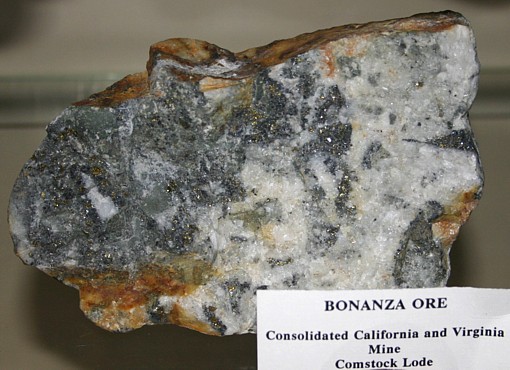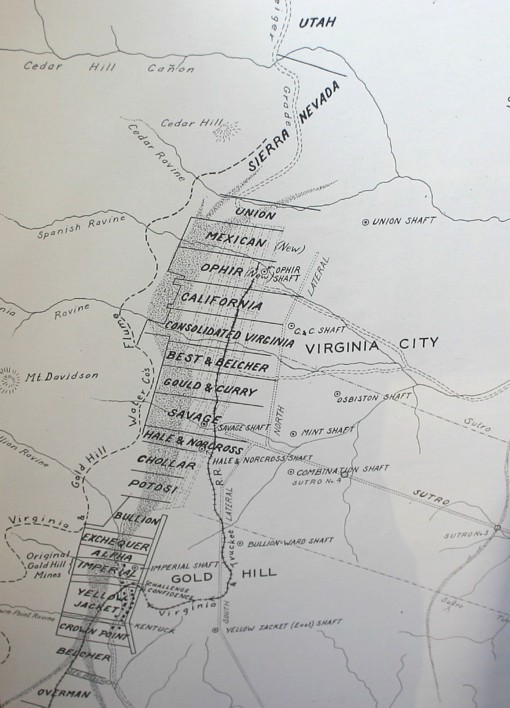The first extraction mill started up for the reduction of silver ores was that known as the "Pioneer," and was located at the Devil's Gate, just where the warlike "Silverites" built their fort at the time of the Indian troubles. Other stamp mills started up within a few days after this first one went into operation and soon there were many at work in all directions. The early mill men knew but little about working silver ores, and all manner of experiments were tried with a view to the thorough amalgamation of the silver contained in the rock that was crushed. This, in the opinion of most superintendents of mills, was to be accomplished by the use of chemicals. A more promiscuous collection of strange drugs and vegetable decoctions never before was used for any purpose. The amalgamating pans in the mills surpassed the caldron of Macbeth's witches in the variety and villainousness of their contents.
Not content with blue-stone (sulfate of copper), salt, and one or two other simple articles of known efficacy, they poured into their pans all manner of acids; dumped in potash, borax, salt peter, alum, and all else that could be found at the drug-stores, then went to the hills and started in on the vegetable kingdom. They peeled bark off the cedar-trees, boiled it down till they had obtained a strong tea, and then poured it into the pans where it would have an opportunity of attacking the silver stubbornly remaining in the rocky parts of the ore. The native sage-brush, which everywhere covered the hills, being the bitterest, most unsavory, and nauseating shrub to be found in .any part of the world, it was not long before a genius in charge of a mill conceived the idea of making a tea of this and putting it into his pans. Soon, the wonders performed by the " sage-brush process," as it was called, were being heralded through the land.
The superintendent of every mill had his secret process of working the silver ore. Often, when it was supposed that one of the superintendents had made a grand discovery, the workmen of the mill were bribed to make known the secret. To guard as much as possible against this, the superintendent generally had a private room in which he made his vile compounds. " Process-peddlers," with little vials of chemicals in their vest pockets, went from mill to mill to show what they could do and would do, provided they received from $5,000 to $20,000 for their secret. The object with many inventors of " processes " appeared to be to physic the silver out of the rock, or at least to make it so sick that it would be obliged to loose its hold upon its matrix and come out and be caught by the quicksilver lying in wait for it in the bottom of the pans. Had it been in the dark ages that these experiments were in progress, the efficacy of the blood of human victims would doubtless have been tried; they would occasionally have hoisted an honest miner up from the subterranean depths and cut his throat over a pan. The "process-peddlers " finally became a worse nuisance than even lightning-rod men have been the limited space of country to which they were confined being considered and the mill men became disgusted with all the patent processes their own as well as those of others and soon little, save salt and blue-stone, was used in the pans. It was found that thorough grinding and careful working of the ore was. what was required. During the first few years that they were experimenting on the Comstock ores, in the many new and inefficient mills, millions of dollars in silver and gold were lost in the tailings ; that is, in the pulverized ore that ran away from the mills after it had been operated upon in the pans, settlers, and other apparatus for the saving and amalgamation of silver by the wet-process. These tailings flowed from the mills into the canons and were swept down into the Carson River, thence down to the " sink " or lake into which the river empties. These millions still lie in the bed of the Carson River and in the bottom of the sink. Had any man thought of saving these tailings in the early days of milling, by putting a flume into Gold Canon and running them to some flat or valley where they could have been dumped in a great heap, all that is now lost would have been saved, and the originator of the enterprise would have made half a dozen big fortunes. The Mexicans knew the value of these tailings and worked them, but they always do things on such a small scale that what they obtained was a mere trifle, and nobody thought of collecting the whole of the tailings running to waste in the canons and saving them in bulk ; besides, the price of milling at that time was so high about $50 per ton that the general impression was that it would not pay to save the whole mass of tailings.
Two Mexicans were at work all one summer in Gold Canon, at Silver City, at concentrating and working the tailings that were flowing down the stream, a mere rill of muddy water. They caught the tailings in a small reservoir, from which they took them and spread them on a table that stood at an inclination of about thirty degrees. They then threw water over the tailings with a small dipper, beginning at the top of the table and gradually working downward until they reached the bottom, at which point, where the end of the table rested on the ground, would be found some pounds of sulfide of silver, with some particles of amalgam and quicksilver that had escaped from the mills. This they placed upon a platform of boards, called a "patio" and when several hundred pounds had been saved, sulfate of copper, salts, and quicksilver, in proper proportions, were added to the mass of sulfide and tailings, and the whole was mixed up as builders mix mortar. When thoroughly mixed, the whole mass was drawn together into a round heap, and allowed to stand and sweat and digest in that shape for a certain number of hours. It was then spread out and worked over, giving it the benefit of the air for a time, when it was again heaped up to digest. This being several times repeated, the operation . was complete, and the silver, amalgamated with quicksilver, was washed out in a pan or rocker.
This is the famous Mexican ''patio ' process on a small scale. At the mines in Mexico they have large, circular patios, paved with stone or tamped with tough clay, in which horses are driven about to tread and knead the pulverized and moistened ore. It is, however, the same thing in effect as the process described above. The two Mexicans mentioned worked all summer, and the supposition was that they were about "making grub," but after they left, the butcher of whom they obtained their meat stated that they took away with them about $3,000 each ; that they were in the habit of bringing their bullion to his shop every Saturday night to weigh it, therefore he knew what they had been doing all the time, but had promised to keep their secret, as they were afraid of being driven away before winter if it were known that they were making money. After freshets in the canon the miners used to go out and collect amalgam by digging it out of the crevices in the rocks with knives, or scooping it out with spoons. Having retorted this, they would take it to a blacksmith's forge, and make rings out of it by melting it and pouring it into a mould cut in an adobe or piece of brick. In this way they made rings that would weigh an ounce or more. Notwithstanding all these evidences of the richness of tailings it was long before men began to work them in any regular or scientific manner. At length, however, shallow flumes were put up on the canons in which the tailings were concentrated and the sulfides caught on strips of coarse blanketing placed in the bottom of the sluices, and, finally, huge reservoirs were constructed in which the whole of the tailings were caught and saved in bulk, it being found that they could be worked at an expense not exceeding four or five dollars per ton. With the tailings there is always caught more or less amalgam and quicksilver. It appears to be impossible to save all the gold and silver contained in ore by any one process; indeed, after it has been worked over several times, and in several different ways, the tailings that finally escape still contain gold, silver, and quicksilver, but a much larger per cent is at present saved than formerly.
Return
to The Nevada Mining Rush Page:
Nevada Gold Rush Mining History


